Serviços Personalizados
Artigo
Indicadores
Links relacionados
-
 Citado por Google
Citado por Google -
 Similares em Google
Similares em Google
Compartilhar
South African Journal of Industrial Engineering
versão On-line ISSN 2224-7890
versão impressa ISSN 1012-277X
S. Afr. J. Ind. Eng. vol.34 no.2 Pretoria Ago. 2023
http://dx.doi.org/10.7166/34-2-2887
CASE STUDIES
The application of Six Sigma to improve the yield of plastic injection molding
C.T. HsiaoI; C.P. LinII; P.H. FanIII, *
IThe author was enrolled for an PhD degree in the College of Management, National Taipei University of Technology, Taiwan, Republic of China
IICollege of Management, National Taipei University of Technology, Taiwan, Republic of China
IIIDepartment of Business Administration, Minghsin University of Science and Technology, Taiwan, Republic of China
ABSTRACT
Plastic injection molding has complex process parameters. The Six Sigma improvement method mainly uses quality control and statistical methods to improve product quality, so as to reduce the cost and waste caused by defective products. Taiwan is the world leader for original equipment manufacturing in the laptop industry, and related peripheral accessories are also a major concern of customers. The subject of this study was a professional supplier of laptop batteries. Through the collection of customer complaint data, it was found that battery case deformation was the most important problem for customers. Therefore, in order to remain competitive, the battery case deformation problem needed to be overcome first. Enterprises need to improve their existing processes to reduce the rate of product defects, improve output efficiency and product quality, and reduce production costs, so as to improve their competitiveness in the industry.This study took a Taiwanese company as an example to improve the plastic injection process through the improvement steps of Six Sigma. In this process, two key process factors, namely the injection speed and the cooling time, were identified by analytical tools. After calculating customers' daily product demand, the most suitable parameters were found using the 'design of experiments' method. The results showed that the process capacity and product yield could be significantly improved. The key to the success of this Six Sigma project was the project implementer's design of the experiment.
OPSOMMING
Plastiek spuitgietwerk het komplekse prosesparameters. Die Six Sigma-verbeteringsmetode gebruik hoofsaaklik kwaliteitsbeheer en statistiese metodes om produkkwaliteit te verbeter, om sodoende die koste en vermorsing wat deur gebrekkige produkte veroorsaak word, te verminder. Taiwan is die wêreldleier vir die vervaardiging van oorspronklike toerusting in die skootrekenaarbedryf, en verwante randtoebehore is ook 'n groot bekommernis van kliënte. Die onderwerp van hierdie studie was 'n professionele verskaffer van skootrekenaarbatterye. Deur die insameling van kliënteklagtedata is gevind dat batterykasvervorming die belangrikste probleem vir kliënte was. Daarom, om mededingend te bly, moes die batterykas-vervormingsprobleem eers oorkom word. Ondernemings moet hul bestaande prosesse verbeter om die tempo van produkdefekte te verminder, uitsetdoeltreffendheid en produkkwaliteit te verbeter, en produksiekoste te verminder, om hul mededingendheid in die bedryf te verbeter. Hierdie studie het 'n Taiwanese maatskappy as 'n voorbeeld geneem om inspuitingsproses van die plastiek te verbeter deur die verbeteringstappe van Six Sigma. In hierdie proses is twee sleutelprosesfaktore, naamlik die inspuitspoed en die verkoelingstyd, deur analitiese instrumente geïdentifiseer. Nadat klante se daaglikse produkaanvraag bereken is, is die mees geskikte parameters gevind deur die 'ontwerp van eksperimente'-metode te gebruik.
Die resultate het getoon dat die proseskapasiteit en produkopbrengs aansienlik verbeter kan word. Die sleutel tot die sukses van hierdie Six Sigma-projek was die projekimplementeerder se ontwerp van die eksperiment.
1. INTRODUCTION
1.1. Research motives
With the development of industry, plastic materials have become the most widely used non-metallic manufacturing materials. Plastic materials have many advantages, such as being lightweight and having high insulation, corrosion resistance, ductility, and high plasticity, which allow them to be made into a variety of shapes and products. Plastic has become an indispensable part of today's life [1].
Taiwan is the leading original equipment manufacturer (OEM) of 3C (computer, communications, consumer electronics) products in the world, and plastic injection molding parts account for a certain proportion of the region's output. Electronic 3C products have shorter life cycles. As a result, in order to reduce inventory pressure, most of the major international factories only purchase goods when there is a need, which has caused the demand for small and diverse orders to become the norm. Therefore, production lines must have good quality and efficient production, so as to meet the demand effectively and supply goods quickly.
Taiwan is the leading original equipment manufacturer (OEM) of the laptop industry in the world, and related peripheral accessories are also a major concern of customers. The object of this study was a professional supplier of laptop batteries. Through the collection of customer complaint data, it was found that battery case deformation was the most important customer concern. In order to remain competitive, the battery case deformation problem needed to be overcome first. Therefore, it was necessary to improve the yield of the process, decrease the amount of defective products, and then reduce the number of customer complaints and reduce wear and tear. Enterprises need to improve the existing processes to reduce the rate of product defects, improve output efficiency and product quality, and reduce production costs, so as to improve competitiveness in the industry.
1.2. Research purposes
The process of plastic manufacturing includes many processing methods. Among them, injection molding is most widely used. As long as the mold design is good, products meeting the demand can be produced. However, process improvement involves many factors, and a complete set of logical steps is required. Six Sigma is a set of scientific management models that is based on data and is targeted at customers. It has been widely used in the manufacturing industry. It adopts the process view, and uses the concept of continuous improvement, making it suitable for production process management and process improvement in helping to improve the efficiency and performance of the manufacturing process, and thus improving customer satisfaction and profitability [2, 3]. The purpose of this study was to improve the plastic injection process through the improvement steps of Six Sigma.
2. LITERATURE REVIEW
In this study, Six Sigma's DMAIC (define, measure, analyse, improve, and control) improvement steps were used to improve plastic injection molding, and Six Sigma was used to find the reasons for the defect rate in the original process. Therefore, plastic injection molding and Six Sigma formed the theoretical basis of this study.
2.1. Plastic injection molding
Plastic injection molding is a process of producing parts made of thermoplastic or thermosetting plastic.
2.1.1. Characteristics of plastic raw materials [4,5]
According to the characteristics of plastic raw materials, they can be roughly divided into 'thermoplastic' and 'thermosetting'.
i. Thermoplastic
Thermoplastics are plastics that soften when heated and harden when cooled, and this process can be repeated. The molecular chain structure of thermoplastics is linear and branched, and there will be chemical reactions between the molecules. The heating or cooling process of thermoplastics is a physical reaction.
ii. Thermosetting plastics
Heating can soften and liquidise thermosetting. A chemical reaction will occur after the heating temperature reaches a certain level. After cooling and fixing, heating cannot make the plastic soften and liquidise again, and the products are processed using this characteristic. The mold is filled under pressure to solidify into products with a definite shape and size.
2.1.2. Principle
Plastic injection technology is used to manufacture a variety of plastic products. The injection molding occurs as follows. First, by heating the injection molding machine to a high temperature, granular plastic particles are melted into a liquid that can flow, and this melted raw material is injected into a mold under high pressure. Second, the mold goes through a period of cooling and temperature reduction. Finally, the mold is opened to complete the final plastic product.
2.1.3. Process
The process of plastic injection molding is roughly divided into the five steps of plastification, injection, packing pressure, cooling, and demolding, as shown in Figure 1. During the manufacturing process, these five stages operate in continuous cycles. With the help of automated manufacturing, manufacturers can efficiently produce a huge number of plastic products [6].
Step 1: Plastification
During plastification, raw materials are melted in a barrel at high temperatures. Depending on the characteristics of the plastic material being used, the processing temperature is set in the injection molding machine to ensure that the plastic particles are melted at the correct temperature.
Step 2: Injection
During injection, the plastic materials are filled and injected into the mold through a screw. The designed space of the mold is used to shape the plastic. At this time the parameters of the injection machine must be adjusted in accordance with the plastic injection molding conditions, so as to avoid subsequent problems such as inappropriate sizes and burrs.
Step 3: Packing pressure
After the plastic material has filled the mold, the space inside the mold continues to be pressurised to ensure the tightness of the plastic material filling and to avoid the backflow of the material.
Step 4: Cooling
During the cooling period, the product is cooled and shaped quickly in the mold.
Step 5: Demolding
During demolding, the plastic product is removed from the mold.
2.1.4. Research on plastic injection molding
Plastic injection molding that involves molds and products of plastic material is a complicated process. The production factors include the production cost, process speed, human factors engineering, and aesthetics. When designing a product, the quality of mold production should be considered. When plastic is injected into the hole of a mold, the mold must be evenly filled by controlling the flow of plastic during the filling stage, so that it takes the same amount of time each time the mold is filled. To maintain the same amount of time for the plastic filling process was difficult in the past owing to the need to adjust the thickness of each section and the cumbersome production process. Therefore, methods should be used to find optimised process conditions [7] [8].
When the outer case of a product is processed by plastic injection, the quality defects can be attributed to factors such as poor filling procedures, warpage, deformation, shrinkage, mold marks, and internal stress. In order to solve such quality problems, this study applied DOE to find the injection conditions. The type of injection conditions and process factors determine the warping and deformation degree of products with thin cases. Through studying the causes of these defects, it was found that previous production processes used too much pressure. As a result, pressure could accumulate inside the product and form internal stress. The injection process is set according to the mold temperature, melt temperature, and pressure time. If there are any problems, products with thin cases may show different degrees of warping or deformation. In the past, the injection molds of products with thin cases used small injection point sizes and shorter packing pressure times. However, in order to save costs and to reduce the time needed to find the optimal conditions related to the process, DOE is now used to find the optimal conditions of injection, as it is an efficient method. Therefore, it is now possible to set the optimal process condition factors and find the minimum warping and deformation qualities of the resulting product [9].
The simulation of the optimal method for the plastic injection manufacturing process was to apply the model to improve the stability of the process and to achieve product accuracy. The accuracy in the micro stage was applied to a transparent CD plastic case for structural considerations. The optimal method was to use composite methods to reduce the warpage and deformation of the injection molded product. The design and selection and control of process conditions, such as the thickness of the ribs, the position of the gate, and the change of process conditions, were used to find the optimal process method [10].
The holding pressure, injection speed, mold temperature and melt temperature were systematically changed to measure the shrinkage data for seven thermoplastic polymers compounds: PC, PS, ABS, HIPS, PBT, HDPE, and PBT-GF30. It was found that the melt temperature and holding pressure of the plastic had the greatest impact on the shrinkage of the injection product, while the mold temperature and injection speed had little effect on the shrinkage of the injection product; therefore, it was possible to find out the interaction between the glue injection and the process conditions [11].
The packing pressure, time, and mold shape were applied to study the shrinkage of the amorphous polystyrene finished product. It confirmed that, by increasing the holding pressure, the shrinkage in the plane direction of the finished product varied by between 0.1% and 0.6%, while the shrinkage in the thickness direction of the finished product was between about 1% and 10%. The holding time would only affect the shrinkage of the finished product if it were less than the curing time of the gate. If more plastic were not extruded in the packing state, the shrinkage in the flow direction of the finished product would increase [12].
2.2. Research on Six Sigma
Erbiyik and Saru (2015) described how to implement Six Sigma in the automotive industry's supply chain using the DMAIC flow process, and observed and analysed the underlying and actual defects to reduce and eliminate the real cause of the programme failure, then constructed the relevant Plato and implemented the improved measures [13].
Srinivasan, Muthu, Devadasan, and Sugumaran (2014) employed the six sigma DMAIC method by implementing circular fins on bare pipes and increasing the heat transfer rate in the exhaust flue to reduce the heat. As a result, they successfully improved the furnace's overall efficiency, raised the standard deviation level from 1.34 to 2.01, and saved Rs. 340,000 of the annual cost [14].
Cai Yahan (2021) proposed using the Six Sigma DMAIC method as a framework to explore how to maintain the consistency of quality in the process. By collecting and analysing the data, that could define the customer's needs and the key factors that affected the quality, and propose more efficient improvement policies [15].
Chen Jianliang (2017) applied Six Sigma to improve inventory management for a company that produced smartphone panels. Statistical methods were used to identify and address the key factors impacting the inventory management process, thereby enhancing the internal competitiveness of the enterprise [16].
3. METHODOLOGY OF SIX SIGMA
Six Sigma was developed in the mid-1980s as a management strategy to improve quality and reduce process variation, and was first promoted by Motorola. Later, after being popularised by Jack Welch, chief executive officer of General Electric, Six Sigma became that company's core management philosophy. Six Sigma has a complete set of improvement procedures. If the object of improvement is a process that is currently running, then the steps of DMAIC can be used; however, if the object of improvement is the design of a new product/service or the redesign of an existing product/service, the process can follow the steps of defining, measurement, analysis, design, and verification (DMADV), as shown in Figure 2.

The objective of this study was to reduce the number of product defects in the existing process. Therefore, this study adopted the steps of DMAIC. The details of each step and the related tools used are shown in Table 1.
4. CASE ANALYSIS
The subject of this study was a professional supplier of laptop batteries. This company had recently received requests from customers to improve the process yield and to decrease the product defect rate, so as to reduce the number of customer complaints and wear and tear.
4.1. The definition stage
In the definition stage, the first step was to understand what problems the customer was concerned about. Through investigation, this study learned that most customer complaints were related to battery case deformation. The battery case was mainly divided into the top case and the bottom case, which were assembled to create the final shape. Through further investigation of the annual defect rate, among the five models (A, B, C, D, and E), it was found that the defect rate of model C was the highest, as shown in Figure 3. Among the defects found, the defect rate for the top case was 7.3%, while the defect rate for the bottom case was 7.7%. Therefore, this study selected products of model C as the object of the improvement project, and expected to reduce the defect rate to below 3% by using Six Sigma.

A flow chart review was used to understand the focus and scope of improvement. After the verification of the flow chart, it was found that the mold design and the injection molding process were the key processes producing the deformation. Therefore, this study conducted an exploration of these two processes to understand further the details of the manufacturing process, as shown in Figures 4 and 5.

4.2. Measurement
After determining the key improvement processes, the critical to characteristic (CTC) in the measurement phase was found, as shown in Table 2. For one month, the defect rates of the upper and bottom cases were collected. During this period, the worst defect rate for the top case was 7.6% and the best defect rate was 3.4%, while the worst defect rate and the best defect rate for the bottom case were 7.85% and 4.8% respectively, as shown in Figure 6.

4.3. Analysis
During the analysis stage, field operators, research and development engineers, and the quality assurance supervisor carried out brainstorming together. Personnel, machines, materials, methods, and cycles were used to expand the cause-and-effect diagram, and the injection gate quantity, the cooling time, the injection speed, and the injection pressure were selected as key factors, as shown in Figure 7. Then univariate influence experiments were carried out respectively on the four factors affecting the defect rate. Data verification revealed that the injection gate quantity had little influence on the defect rate, as shown in Table 3. Therefore, this study selected three factors, namely injection pressure, injection speed, and cooling time, to carry out the statistical and experimental analysis and to determine the factors with the greatest influence.

4.4. Improvement
During the analysis stage, the experimental factors were the injection pressure, injection speed, and cooling time. The factor levels were determined after discussions between the engineers and the field operators. The three-factor and two-level complete factor analyses were adopted. In addition, repeated experiments were carried out, and the levels of each factor were set, as shown in Table 4.
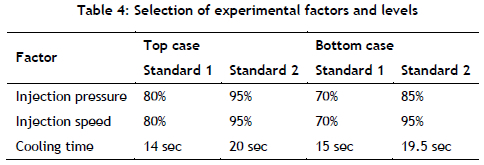
4.4.1. Design of the experiment and analysis of the top case
This study first carried out the experiment for the top case of the battery, and the results indicated the defect rate, as shown in Table 5.
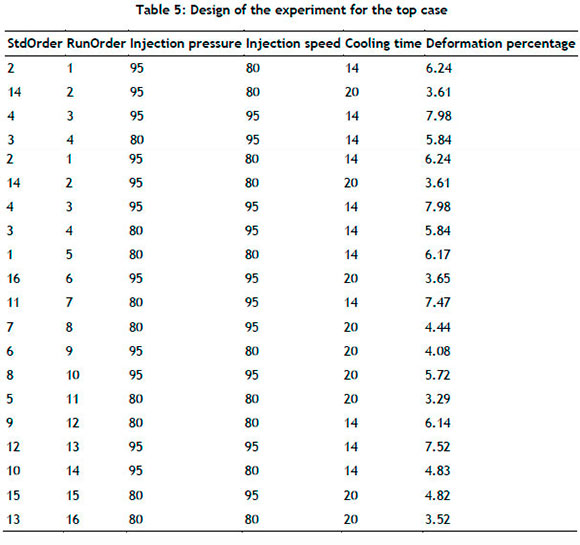
This study next performed a variance analysis, as shown in Table 6. It could be seen that the p-values for the cooling time and injection speed (%) were less than 0.05, which had a significant effect on the deformation rate. From the Pareto chart, shown in Figure 8, it could also be seen that the effects of both the p-value and the injection speed were significant.
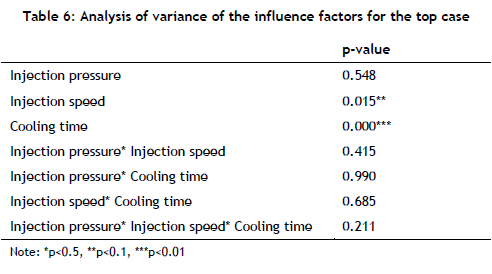

Next this study eliminated other non-significant factors before carrying out experimental confirmation and residual analysis, as shown in Figure 9, after which the correlations among injection speed, cooling time, and defect rates were analysed. As seen in Figure 10, the injection speed (%) was positively correlated with the defect rate; that is, the higher the injection speed, the greater the defect rate. The cooling time was negatively correlated with the defect rate; that is, the longer the cooling time, the lower the defect rate. Figure 10 also shows that the variation range of the cooling time was relatively significant.
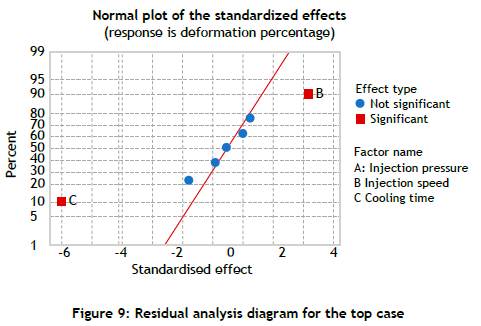
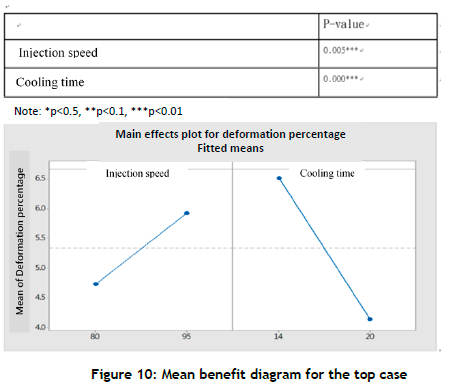
After the key factors had been analysed, the optimum conditions could be set for the production line characteristics. According to customer demand, the daily product demand was calculated as 2 500 pieces, and it was a designated line. Therefore, it was not necessary to consider the need to change molds or lines frequently. The production line worked 24 hours per day in three shifts. The worst defect rate for the top case was 5% when the production was set according to the new parameters of the key factors. The cycle time for each product was calculated as 32.832 seconds, of which 11.33 seconds was the time it took to manufacture a product, excluding the cooling time. Therefore, 21.5 seconds was set as the optimal cooling time, as shown in Figure 11. The injection speed was also a significant factor causing various product defects. Based on the analysis of the data from the previous adjustment observations, it was found that the risk of material shortage and the occurrence of welding lines increased rapidly after the injection speed fell below 75%, as shown in Figure 12. Considering the production capacity and quality requirements, this study decided to use a combined method of an injection rate of 75% and a cooling time of 21.5 seconds, and carried out production according to the set conditions. Taking one hour as the unit, this study conducted sample tests based on molding products for 10 hours without stopping, and recorded the defect rate for each batch of products. As shown in Figure 13, all defect rates were below 1.9%.
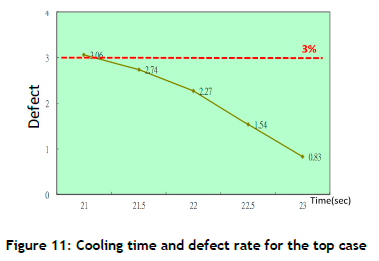
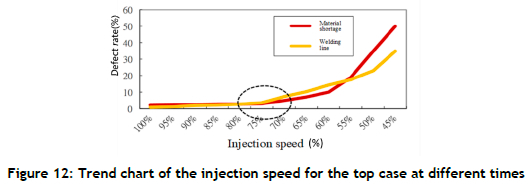
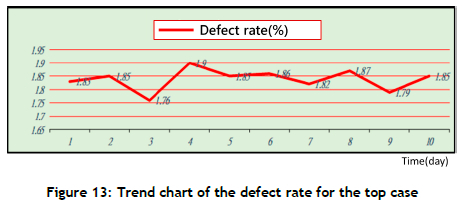
4.4.2. Design of the experiment and analysis of the bottom case
Through further design of the experiment for the bottom case of the battery, it was found that the product structure and composition were similar to those of the top case and that its influence factors tended to be consistent with those of the top case. The results are shown in Table 7.
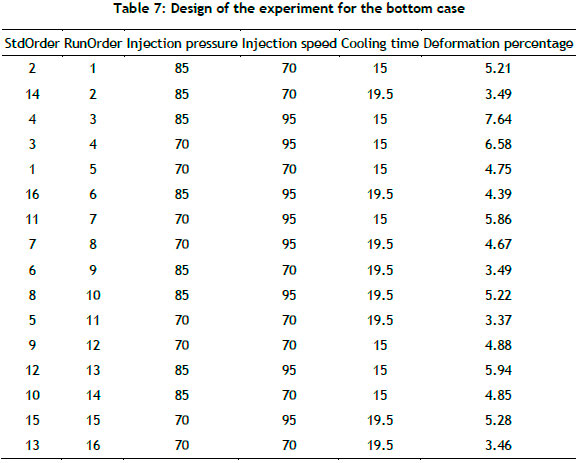
Based on the analysis of variance, as shown in Table 8, it could be seen that the p-values for the cooling time and the injection speed (%) were less than 0.05, which had a significant effect on the defect rate. From the Pareto chart, shown in Figure 14, it could also be seen that the effect of both factors was significant.
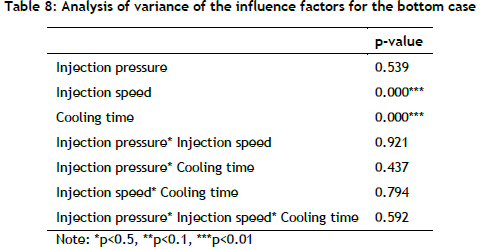
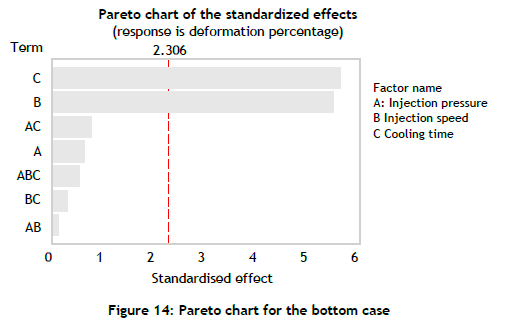
By eliminating other non-significant factors and conducting experimental confirmation and residual analysis, as shown in Figure 15, the same conclusion as that for the top case was obtained. The injection speed (%) was positively correlated with the defect rate, and the cooling time was negatively correlated with the defect rate, as shown in Figure 16.
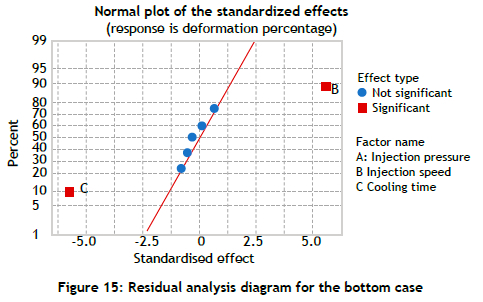
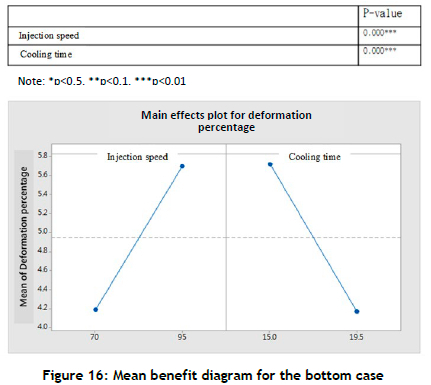
After the key factors had been analysed, the optimum conditions were set further for the production line characteristics. According to customer demand, the daily product demand was calculated as 2 500 pieces. When the production was set according to the new parameters of the key factors, the worst defect rate for the bottom case was 6.2%. The cycle time for each product was calculated as 32.417 seconds, of which 11.6 seconds was the time it took to manufacture a product, excluding the cooling time. Therefore, 21 seconds was set as the optimal cooling time, as shown in Figure 17.
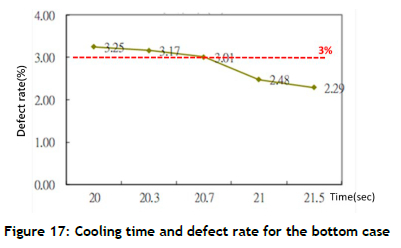
The injection speed was also a significant factor causing various product defects. Based on the analysis of the data from the previous adjustment observations, it was found that the risk of missing material and the welding line would increase rapidly after the injection speed fell below 68%, as shown in Figure 18. Considering the production capacity and quality requirements, this study decided to use a combined method based on an injection rate of 68% and a cooling time of 21 seconds, and carried out production according to the set conditions. Taking one hour as the unit, this study conducted sample tests based on molding products for 10 hours without stopping, and recorded the defect rate of each batch of products. As shown in Figure 19, all defect rates were below 2.25%.
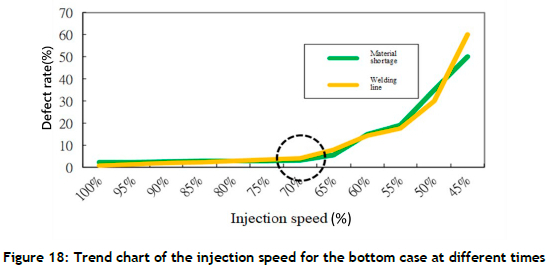
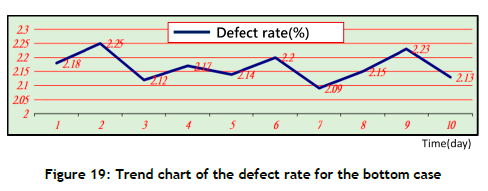
4.5. Control
After the improvement had been confirmed to be effective, it was monitored during the control stage. The optimised conditions in the standard operating procedure were recorded and announced, and relevant training was conducted. The defect rates for the top case and the bottom case were continuously tracked and recorded, as shown in Figure 20. It was found that all of the obtained defect rates were within 3% and achieved the set target value.
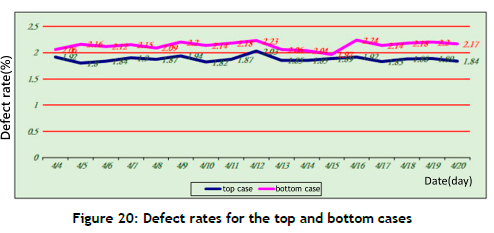
5. CONCLUSION AND SUGGESTIONS
In this study, the plastic injection process was improved by using Six Sigma's DMAIC steps. First of all, during the definition stage, this study used customer complaints and a flow chart review to learn about the focus and scope of improvement. After verification of the flow chart, this study found that the mold design and injection molding process were the key processes that resulted in the deformation. During the measurement stage, this study found critical to characteristic (CTC) and established measurement indicators. During the analysis stage, the causes of the poor production processes were found through brainstorming, and a cause-and-effect diagram was drawn. It was found that the four factors affecting the defect rate were the injection pressure, injection speed, cooling time, and injection gate quantity. After verification, the injection gate quantity was excluded. During the improvement stage, the 'design of experiments' (DOE) and the three-factor and two-level analysis approaches were used to seek the optimal allocations. Finally, the main influencing factors were determined to be an injection rate of 75% and a cooling time of 21.5 seconds for the top case and an injection rate of 68% and a cooling time of 21 seconds for the bottom case. During the control stage, follow-up monitoring was provided and improvements were maintained by adhering to the control plan.
After standardising the production parameters, daily defect rate data was collected between 4 and 20 April, 2020. The maximum daily defect rate for the top case was 2.02%, and for the bottom case it was 2.29%. Both values were below the set target (3%). The result confirmed the effectiveness of this improvement project. Furthermore, based on a monthly average production capacity of 100 000 units, the project's economic benefits were estimated to result in a total savings of NTD 23 760 000.
With the improvement to the whole process, the case company in this study reduced its process defect rate. Moreover, this study enabled the company to learn a complete and effective improvement process. In the subsequent mold testing of other machine models, this study broke the traditional mode of empirical adjustment by introducing Six Sigma, combined with the DOE method, in order to find the reasons for the problems quickly and efficiently. It could solve problems, improve quality, shorten the mold test time, and reduce the number of production line breaks, thus improving the company's market competitiveness and reducing the number of customer complaints.
REFERENCES
[1] Hung, S.B. 2021. Study on the wear of the sliding plate of the clamping unit in the plastics injection molding machine. Thesis for Master of Science, Department of Mechanical Engineering, Kun Shan University, Tainan, Taiwan, R.O.C. [ Links ]
[2] Pande, P.S., Neuman, R.P. & Cavanagh, R.R. 2006. What is design for six sigma? Taipei: McGraw Hill Professional. [ Links ]
[3] Chou, S.W., Huang, K.K., Lee, H.T. & Cheng, C.S. 2017. The application of six sigma methodology in improving the defective rate of ready-to-eat food production. Journal of Quality, 24(1), pp. 29-44. [ Links ]
[4] Lee, C.K., Zheng, Z.H., Xu, Z.J., He, J.Y. & Huang, H.L. 2023. Application of Taguchi experimental method and mold-flow analysis method to improve the volume shrinkage and warpage deformation of an injection molded plastic spur gear. Crisis Management Society, 20(1), pp. 1-9. DOI: 10.6459/JCM.202303_20(1).0001 [ Links ]
[5] Liu, S. 2010. Polymer processing. Taipei: Canghai Bookstore. [ Links ]
[6] EdeX Technology Company. Plastic injection knowledge: 5 common undesirable phenomena and solutions. Available at: https://www.edex.com.tw/. [Accessed on December 25, 2022]. [ Links ]
[7] Seow, L.W. & Lam, Y.C. 1997. Optimizing flow in plastic injection molding. Journal of Materials Processing Technology, 72(3), pp. 333-341. [ Links ]
[8] Chiu, Y.F. 2010. Study on the shrinkage of injection molded product. Thesis for Master of Science, Degree Program of Automation and Precision Engineering, National Chiao Tung University, Hsinchu, Taiwan. [ Links ]
[9] Huang, M.C. & Tai, C.C. 2001. The effective factors in the warpage problem of an injection-molded part with a thin shell feature. Journal of Material Processing Technology, 110(1), pp. 1-9. [ Links ]
[10] Subramanian, N.R., Lin, T. & Seng, Y.A. 2005. Optiming warpage analysis for an optical housing. Mechatronics, 15, pp. 111-127. [ Links ]
[11] Jansen, K.M.B., Dijk, D.J.V. & Huesselman, M.H. 1998. Effect of processing conditions on shrinkage in injection molding. Polymer Engineering and Science, 38(5), 838-846. kage measurements on polystyrene injection molded products. Polymer Engineering and Science, 38(2), pp. 254-264. [ Links ]
[12] Erbiyik, H. & Saru, M. 2015. Six sigma implementations in supply chain: An application for an automotive subsidiary industry in Bursa in Turkey. Procedia - Social and Behavioral Sciences, 195, pp. 2556-2565. [ Links ]
[13] Srinivasan, K., Muthu, S., Devadasan, S.R. & Sugumaran, C. 2014. Enhancing effectiveness of shell and tube heat exchanger through six sigma DMAIC phases. Procedia Engineering, 97, pp. 2064-2071. [ Links ]
[14] Tsai, Y. 2021. The application of six sigma to process quality improvement research. Thesis for Master of Science, Southern Taiwan University of Science and Technology, Tainan, Taiwan, R.O.C. [ Links ]
[15] Chen, J. 2017. Application of six sigma to reduce inventory - Taking a company as an example. Thesis for Master of Science, National Tsinghua University, Hsinchu, Taiwan, R.O.C. [ Links ]
[16] Jansen, K.M. Pantani, R. & Titomanlio, G. 1998. As-molded shrin [ Links ]
Submitted by authors 16 /Mar 2023
Accepted for publication 4 Aug 2023
Available online 25 Aug 2023
* Corresponding author: garyfan1688@gmail.com
ORCID® identifiers
C.T. Hsiao: https://orcid.org/0000-0002-0001-0642
C.P. Lin: https://orcid.org/0009-0005-0965-7409
P.H. Fan: https://orcid.org/0000-0002-7693-2301














